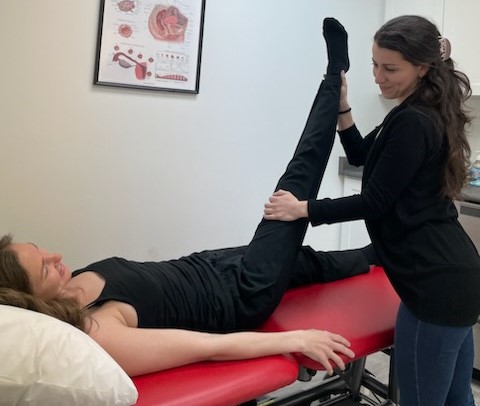
Written by Liron Kvaterman, MScPT, Reg PT, and Michelle Watkin, MScA PT, Reg PT, Pelvic Health Physiotherapists at The WOMB Vaughan
Congratulations on the birth of your new baby(s)! Returning to exercise after giving birth can be a challenging, yet empowering time. Many new moms feel unsure about how to start and would benefit from some guidance in navigating the return to exercise postpartum. While exercise can help you recover and improve your overall health, it’s important to approach it with care. Remember, it took approximately 9 months to grow your baby, and then you birthed them! Whether a vaginal or cesarean birth, your body has gone through significant changes and postpartum recovery takes time. Give yourself some grace and have patience with your recovering body. That being said, when you feel motivated to start your return to any form of activity or exercise, keep reading for our top tips!
When can I return to exercise?
The first 3 months postpartum, also known as the “4th trimester”, is the time to prioritize rest with your baby, but still move your body in a comfortable way. The 4th trimester is usually not the time to be starting and/or progressing any high-intensity exercises such as running, heavy lifting, and jumping, especially when there is often a short supply of energy postpartum. It is important to consider that higher impact activities require more energy and exert more force and pressure on your recovering tissues. Therefore, light to moderate intensity cardiovascular and mobility exercises like gentle yoga, walking, or swimming, are ideal at this stage in your recovery.
Tip: Most importantly, we recommend consulting your Pelvic Health Physiotherapist who will do an assessment with you, as early as 4 weeks postpartum. This can be beneficial both in person or virtually. A postpartum assessment screens for any concerns with the recovery of your abdominal and pelvic floor muscles and other tissues. We help you retrain these muscles, and provide guidance on optimal breathing and movement strategies in your new role as a parent. We also address any symptoms you may be experiencing, including: bladder or bowel concerns, perineal or cesarean scar tissue, and any pain or discomfort. While supporting you with your recovery, we can then guide you to start your return to the activity or exercise of your choosing.

How should I start?
We all have different bodies, environments, interests, goals, and birth experiences, so there is no one-size-fits-all formula to returning to exercise postpartum. However, pregnancy and childbirth affect your “deep core” muscles: diaphragm, abdominals, and pelvic floor; so a great place to start is by reconnecting to and re-coordinating these muscles. We call this coordination the “core breath”. By learning how to breathe better, we can optimize the function of the abdominal and pelvic floor muscles. Isn’t that neat? Once this coordination feels more natural, you can practice it during any meaningful tasks or exercises. Examples include: carrying or rocking your baby, lifting the car seat, climbing stairs, and pushing a stroller.
Tip: In regards to the activity or exercise of your choosing, it’s important to start at a lower intensity and duration, compared to your pre-pregnancy (or even pregnancy) workout routine. The exact intensity and duration is relative to you. Lower-intensity exercises will help rebuild your strength and coordination, without straining your tissues. You need to walk before you can run! For example, can you walk 30 minutes without experiencing symptoms? The key to preventing any strain, injury, or pain, is to start slower, progress gradually, and “listen to your body”.
What does “listen to your body” even mean?
Remember the story of Goldilocks and the Three Bears? Too much exercise can leave you feeling sore and achy, among other pelvic symptoms described below; but not enough movement or exercise can leave you feeling stiff and achy as well. Somewhere in the middle, there’s a “just right”. The key is to find your “just right” and progress gradually in a way that feels comfortable and symptom-free. Eventually your “just right” will be at the level of fitness you desire. Of course this timeline will vary from person to person, depending on your recovery and fitness goals.
What signs and symptoms should I look out for?
During or after exercising, your body (and brain) will communicate if you “overexerted” yourself. It’s important to understand which signs and symptoms to look out for, and what they might mean. Overexertion might have felt like fatigue, soreness, or pain prior to pregnancy, but there are a few extra symptoms to consider now that you’re postpartum. These signs and symptoms include:
- Increased bleeding (lochia) – typically in the first 2 months
- Leakage of urine or stool (any amount)
- Pain anywhere (new or worsening) – especially abdominal, pelvic or perineal
- Pressure, heaviness or bulging (vaginal or rectal)
- Excessive (hard) doming/coning of the abdomen (“diastasis rectus abdominis”)
- Or simply, if you are unable to control your breath or movement/position, the exercise is “too hard”
Tip: We highly recommend seeing a Pelvic Health Physiotherapist if you notice any of these signs or symptoms listed above. We can help you understand why you are experiencing these symptoms, and suggest strategies to mitigate them. For example, lifestyle habits and how you perform your daily tasks and activities may also contribute to how your body is responding.
What other factors should I consider?
There are several other factors that should be taken into consideration when returning to exercise. Sleep status, nutritional status, degree of social support, and other personal factors such as mood, can influence your energy levels, how your tissues recover, and how your body responds to exercise. Your Pelvic Health Physiotherapist can help optimize your recovery by also considering such factors in your care plan.
What is the bottom line?
- Prioritize your recovery in the “4th trimester”.
- Learn to re-connect to and re-coordinate your deep core muscles (as soon as possible).
- Start with low-impact exercise and progress gradually.
- Listen to your body, respecting any signs or symptoms of overexertion.
- Consult a Pelvic Health Physiotherapist for a postpartum assessment, as early as 4 weeks, especially if you are experiencing any bladder, bowel, or pain symptoms. We can also help you navigate other care providers to support and empower you in your recovery.

Wishing you all the best on your postpartum journey.
Warmly,
Liron and Michelle.





